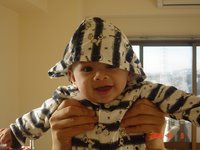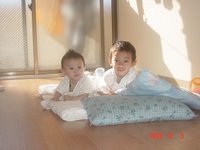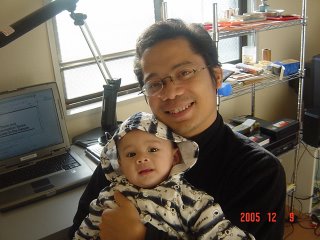
 On Sunday, December 11, Eisaku Ide sensei (aji's thesis advisor) and his wife, Chie invited us to go to Kamakura to see the beauty of fall. They picked us up at 9.30 and we headed for Kamakura.
On Sunday, December 11, Eisaku Ide sensei (aji's thesis advisor) and his wife, Chie invited us to go to Kamakura to see the beauty of fall. They picked us up at 9.30 and we headed for Kamakura.It was cloudy all day but their hospitality and generosity warms our hearts and fill the journey. Wisnu was so excited that he laughed many times in the car. Akira also seemed to enjoy this experience as he stared at building from the car's window and hardly cried during the trip.
The first place we visited was the most important shrine in Kamakura: Tsurugaoka Hachimangu. It was founded by Minamoto Yoriyoshi in 1063, and enlarged and moved to its current site in 1180 by Minamoto Yuritomo, the founder and first shogun of the Kamakura government.

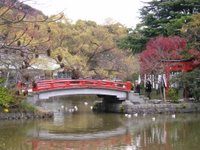 The shrine is dedicated to Hachiman, the kami (shinto's gods) of war, which used to be particularly popular among the leading military clans -- Minamoto family and all samurai in general.
The shrine is dedicated to Hachiman, the kami (shinto's gods) of war, which used to be particularly popular among the leading military clans -- Minamoto family and all samurai in general.Do you know that temple is different from shrine to Japanese? Budhists go to temples to pray but many Japanese who claim that they do not have religions do go to jinja to pray for good luck, health or wealth. When you visit shrines (jinja) in japan, usually you can see :

1. Torii
the gate which marks the entrance to a shrine and designates holy ground. The Gate marks the gateway between the physical and spiritual worlds. The Torii is traditionally made in three pieces, three being a sacred number of the Kami, the gods in Shintoism. It has two upright supports and two crossbars on the top, and is frequently painted vermilion. As hinted by the kanji characters (they mean: tori = bird, i = place), a torii is designed for birds to rest. This is because in Shintoism, birds are considered messengers of the god.
2. Purification fountain-- near the enterance

What to do here? Take the wooden ladle provided to fill it with fresh water and rinse both hands. Then transfer some water into your cupped hand, rinse your mouth and spit the water beside the fountain. You are not supposed to transfer the water directly from the ladle into your mouth nor to swallow the water.
3. Ema --wooden plates to write wishes

The ema are left hanging up at the shrine, where the kami (spirits or gods) can read them. They tend to be fairly uniform in size and shape, but many have different pictures painted on them, of animals or other Shinto imagery, and they often have the word negai (願意) or 'Wish' written along the side. Stereotypically, the image on the plaque would be of a horse, uma or ma in Japanese (馬); ema means, literally, "horse picture". This name originates from the fact that real horses were once offered by the wealthy in exchange for blessings at shrines.
 4. Omikuji --fortune telling paper
4. Omikuji --fortune telling paperWith 100 yen you can get a fortune telling paper-- there are Japanese and English version. After paying, you will be given a wooden box with a hole on top for you to take one wooden stick. When you get one, there is number written there, then the seller will give you the fortune telling paper with the number drawn. The predictions range from daikichi ("great good luck") to daikyo ("great bad luck"). What you need to do is tie the paper around the provided place, just like what Ide sensei and his wife did in the picture, then good fortune will come true or bad fortune can be averted.
Ibu and aji managed to take one each. For ibu, the paper says that ibu will have a good future, the children are healthy, but ibu has to be careful in giving names for children! It also says that if the friendship fails, it must be ibu to be blame. The good thing is if ibu decided to move, ibu'd better hurry! The worst thing is the business goes bankrupt (oh-oh wil it really happen to the company ibu has been working for?)
What about aji? Aji has to rethink about his desires, the business is not good but the children are healthy. Aji also needs to be really careful in choosing names for children. (Believe it or not --some statements are very relevant with our condition)
5. Charms
There are many kinds of japanese charms/amulets we can buy here.
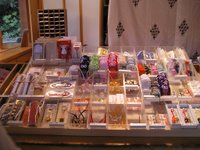
There are charms for good luck, health, study or marriage. (As a matter of fact it's not allowed to take the pictures of those charms--but accidently ibu took one for you to see!) Surprisingly, Ide Sensei and aunty chie bought us one for good health. Thank you, we'll need that!
Anyway, we climbed up the stairs to get inside the shrine. (sorry, we are not allowed to take pictures inside the shrine). Many people pray there. How? First, throw the coin, bow twice, and clap hands twice. After that save your pray, and when you've finished, just bow once.
There are many other interesting things we find around this jinja, so check the next posting out!
(to be continued...)
